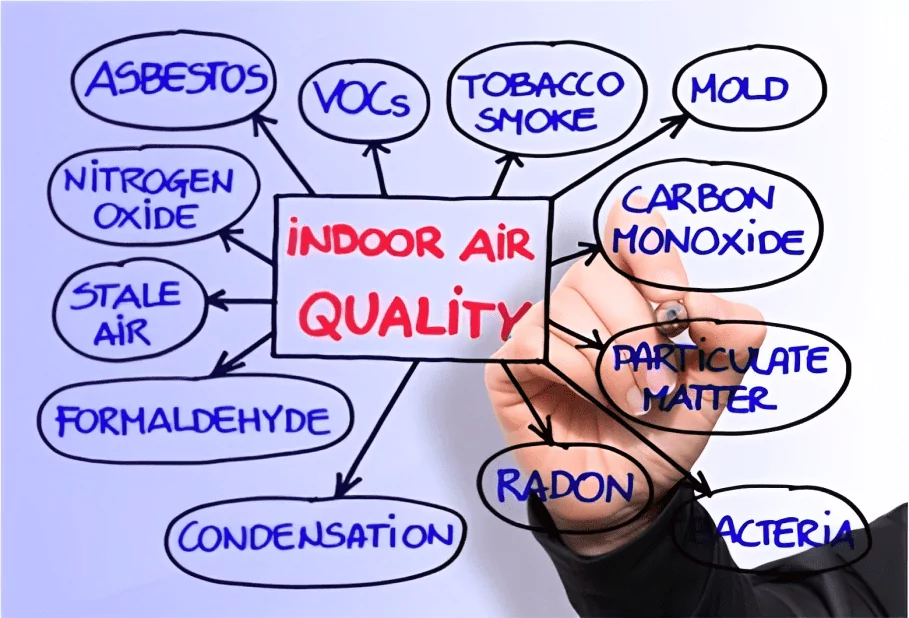How to Improve Airflow In Overcrowded Office?

An increasingly common challenge faced by building owners and managers, especially of office buildings, is how to improve air flow in overcrowded offices. Good indoor air quality (IAQ) is imperative for the health, well-being, and productivity of occupants. Poor indoor air quality can lead to a plethora of health issues and negatively impact the morale and productivity of workers. The key to mitigating such indoor air quality problems lies in enhancing the ventilation and air circulation of indoor spaces.
1 Understanding the Basics
- Indoor Air Quality (IAQ): This refers to the air quality inside buildings, especially as it relates to the health and comfort of building occupants. Factors like contaminants, ventilation, and air flow affect the IAQ.
- Outdoor Air Quality: This pertains to the quality of the air outside a building or structure. While we can’t control outdoor air quality as easily, it’s crucial as it can impact indoor air when outdoor air is used to ventilate indoor spaces.
- HVAC Systems: An acronym for Heating, Ventilation, and Air Conditioning systems, these are central to improving the indoor air quality in office buildings. A well-maintained HVAC system ensures effective air distribution.
2 The Implication of Poor Indoor Air

The consequences of poor indoor air are vast. Occupants in poorly ventilated spaces can experience discomfort, illness, or even long-term health effects. Chemical pollutants, high levels of carbon dioxide, and other contaminants can accumulate in the air inside, exacerbating the issue. This becomes even more pressing with concerns surrounding infectious diseases like COVID-19, which highlight the need for better airflow and air cleaning in occupied spaces.
3 Steps to Improve Air Flow in Overcrowded Offices
- Mechanical Ventilation: Building ventilation systems, especially HVAC systems, play a crucial role in maintaining good indoor air quality. They manage air supply, regulate relative humidity, and filter contaminants. Ensuring that the HVAC equipment is regularly serviced and well-maintained can drastically improve air circulation and indoor air quality.
- Natural Ventilation: Encouraging the use of windows and other openings can be beneficial. Natural ventilation leverages outdoor air to replace stale indoor air, aiding in improving air quality.
- Portable Air Cleaners: Devices like air purifiers, with efficient filters such as HEPA filters, can reduce indoor contaminants. These are particularly useful in spaces with limited ventilation.
- Upper Room UVGI (Ultraviolet Germicidal Irradiation): This method uses UV light to kill or neutralize airborne microorganisms, ensuring a clean air delivery rate and better indoor air.
- Increase Air Supply: Overcrowded offices may benefit from fan systems and exhaust fans that ensure consistent air movement.
- Opt for Efficient Filters: Using filters, especially HEPA filters, in HVAC systems can trap pollutants and enhance air quality. Ensuring clean air delivery rates is essential in offices.
- Monitor Air Quality: Invest in air quality monitors. Monitoring helps identify indoor air quality problems and provides air quality data that can guide interventions.
- Addressing Sources of Contamination: Ensure that areas like photocopy rooms have adequate exhaust grilles. Also, minimize the use of products that release volatile organic compounds (VOCs).
- CO2 Monitoring: Elevated carbon dioxide levels indicate poor air quality. Installing CO2 monitors can alert you when there’s a need for better ventilation.
- Maintain Optimal Relative Humidity Levels: An ideal indoor environment should have relative humidity levels between 40% and 60%.
- Proper Space Planning: Avoid creating enclosed spaces without ventilation. Occupied spaces need a balance of air supply and exhaust.
- Occupational Safety Protocols: In the wake of diseases like COVID-19, offices must consider occupational safety measures, like ensuring clean air and addressing potential indoor air quality issues.
4 How Poor Air Quality Hurts Health and Productivity?
Air quality, both indoors and outdoors, has a profound impact on our health, well-being, and overall performance. With the majority of individuals spending substantial portions of their day indoors, the implications of poor indoor air quality have become even more significant. Here’s a closer look at how poor air quality affects both health and productivity.
Health Impacts of Poor Air Quality

- Respiratory Issues: One of the most immediate and noticeable effects of poor air quality is its impact on the respiratory system. Polluted air can exacerbate conditions like asthma and can cause symptoms such as coughing, shortness of breath, and chest tightness.
- Allergies: Dust, pollen, and mould are common allergens present in poorly ventilated spaces. Inhaling these can trigger allergic reactions, leading to symptoms like sneezing, runny nose, red eyes, and skin rashes.
- Cardiovascular Problems: Long-term exposure to polluted air can increase the risk of heart attacks, stroke, and other cardiovascular diseases.
- Fatigue and Dizziness: Poor indoor air quality, especially in settings with high carbon dioxide levels, can lead to feelings of fatigue, dizziness, and headaches.
- Long-term Health Concerns: Chronic exposure to harmful pollutants and chemicals can lead to serious health problems like lung cancer, heart disease, and respiratory diseases.
- Aggravation of Chronic Conditions: For those already suffering from chronic conditions such as asthma or COPD, poor air quality can exacerbate the symptoms and lead to frequent flare-ups.
- Cognitive Impairments: There are studies suggesting that constant exposure to indoor pollutants can affect cognitive functions, leading to decreased concentration and memory problems.
Productivity Impacts of Poor Air Quality
- Decreased Cognitive Abilities: Reduced air quality has been shown to negatively impact cognitive abilities. This can affect decision-making, strategic planning, and response times.
- Increased Sick Days: Employees who work in poorly ventilated spaces or areas with poor air quality are more likely to fall ill, leading to increased absenteeism.
- Reduced Energy Levels: As mentioned earlier, poor air quality can cause fatigue. When employees feel tired and drained, their work output and efficiency are likely to decrease.
- Mood Alterations: There’s a notable connection between air quality and mood. Poor air quality can lead to feelings of irritability, anxiety, and low morale, which in turn can impact teamwork, collaboration, and overall work quality.
- Long-Term Employee Health Costs: Organizations might find themselves facing increased health insurance premiums or medical costs for employees due to health issues stemming from poor indoor air quality.
- Employee Turnover: If an office environment is consistently uncomfortable due to poor air quality, companies might see a higher turnover rate as employees seek healthier workplaces.
5 HVAC Systems and Ventilation
Heating, Ventilation, and Air Conditioning (HVAC) systems are central to ensuring comfort and good air quality in buildings. Whether in homes, office spaces, or industrial complexes, these systems play a critical role in maintaining a healthy indoor environment. Let’s delve into the intricacies of HVAC systems and the significance of proper ventilation.
What is an HVAC System?

An HVAC system is a comprehensive system designed to regulate the environment within a building or a room. Its main components include:
- Heating Component: This includes furnaces, heat pumps, and boilers. They warm the air during cold seasons.
- Cooling Component: Comprising air conditioners and cooling towers, they keep spaces cool during hot periods.
- Ventilation Component: Essential for both air exchange and moisture control. It includes equipment like air handlers, ductwork, and filters.
The Importance of Proper Ventilation
- Air Quality: Proper ventilation replaces stale indoor air with fresh outdoor air, reducing the concentration of pollutants and contaminants. This is vital for preventing indoor air pollution.
- Moisture Control: Ventilation helps reduce the amount of moisture in the air, mitigating mold growth and other moisture-related problems.
- Temperature Regulation: Good ventilation ensures a balanced indoor temperature by circulating air effectively.
- Eliminating Odors: Adequate ventilation can help remove unpleasant odors, ensuring a more comfortable living or working environment.
How HVAC Systems Facilitate Ventilation?
- Air Exchange: HVAC systems are designed to either circulate the indoor air, draw in fresh outdoor air, or expel stale indoor air. This constant exchange ensures indoor spaces have fresh air at all times.
- Air Filtration: As air circulates through the HVAC system, it passes through filters designed to trap pollutants like dust, pollen, and even certain microbes. This results in cleaner air being distributed throughout the building.
- Humidity Control: Many HVAC systems come with dehumidifiers or humidifiers, ensuring that indoor humidity levels stay within a comfortable range.
- Balanced Air Distribution: Through a series of ducts, fans, and vents, HVAC systems distribute air evenly, preventing stagnant areas where pollutants can accumulate.
Best Practices for HVAC Systems and Ventilation
- Regular Maintenance: HVAC equipment requires routine checks and maintenance to function efficiently. This includes cleaning or replacing filters, inspecting ducts, and ensuring all components work seamlessly.
- Adequate Filtration: Using high-quality air filters, like HEPA filters, can significantly improve indoor air quality. Filters should be changed or cleaned regularly.
- Monitoring Air Quality: Employing indoor air quality monitors can provide insights into when ventilation may need to be increased or if there are specific issues that need addressing.
Optimizing Air Flow: Keeping vents unblocked, ensuring ducts are free of leaks, and optimizing fan settings can enhance air distribution and quality. - Integrating Natural Ventilation: Whenever possible, complementing HVAC ventilation with natural ventilation (like opening windows) can improve air quality even further.
6 Wrapping Up
Building owners and office managers need to prioritize air quality monitoring and interventions to ensure healthy indoor environments. Properly installed and maintained HVAC systems, along with supplemental measures like air purifiers, ceiling fans, and UVGI, can significantly enhance air quality in overcrowded offices. Given that many people spend a significant portion of their day in office buildings, these steps are not just essential for health but also for productivity and morale.
Remember, while tackling indoor air pollution and ensuring good indoor air quality can be a challenge, with the right measures, tools, and awareness, it is entirely feasible. Emphasize the importance of fresh air, efficient airflow, and a keen eye on the health of the indoor space to ensure that every person working in the office feels comfortable, safe, and productive.
Community Q&A
About This Article
This article has been viewed 410 times.



